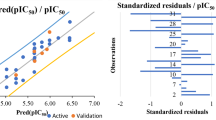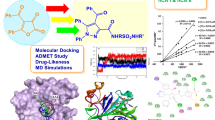Abstract
Human intestinal carboxyl esterase (hiCE) is a drug target for ameliorating irinotecan-induced diarrhea. By reducing irinotecan-induced diarrhea, hiCE inhibitors can improve the anti-cancer efficacy of irinotecan. To find effective hiCE inhibitors, a new virtual screening protocol that combines pharmacophore models derived from the hiCE structure and its ligands has been proposed. The hiCE structure has been constructed through homology techniques using hCES1’s crystal structure. The hiCE structure was optimized via molecular dynamics simulations with the most known active hiCE inhibitors docked into the structure. An optimized pharmacophore, derived from the receptor, was then generated. A ligand-based pharmacophore was also generated from a larger set of known hiCE inhibitors. The final hiCE inhibitor predictions were based upon the virtual screening hits from both ligand-based and receptor-based pharmacophore models. The hit rates from the ligand-based and receptor-based pharmacophore models are 88% and 86%, respectively. The final hit rate is 94%. The two models are highly consistent with one another (85%). This proves that both models are reliable.
Similar content being viewed by others
References
Tsuruo T, Matsuzaki T, Matsushita M, Saito H, Yokokura T. Antitumor effect of CPT-11, a new derivative of camptothecin, against pleiotropic drug-resistant tumors in vitro and in vivo. Cancer Chemother Pharmacol, 1988, 21: 71–74
Tanizawa A, Fujimori A, Fujimori Y, Pommier Y. Comparison of topoisomerase I inhibition, DNA damage, and cytotoxicity of camptothecin derivatives presently in clinical trials. J Natl Cancer Inst, 1994, 86: 836–842
Satoh T, Hosokawa M, Atsumi R, Suzuki W, Hakusui H, Nagai E. Metabolic activation of CPT-11, 7-ethyl-10-[4-(1-piperidino)-1-piperidino]carbonyloxycamptothecin, a novel antitumor agent, by carboxylesterase. Biol Pharm Bull, 1994, 17: 662–664
Sawada S, Yokokura T, Miyasaka T. Synthesis of CPT-11 (irinotecan hydrochloride trihydrate). Ann NY Acad Sci, 1996, 803: 13–28
Thompson J, Zamboni WC, Cheshire PJ, Lutz L, Luo X, Li Y, Houghton JA, Stewart CF, Houghton PJ. Efficacy of systemic administration of irinotecan against neuroblastoma xenografts. Clin Cancer Res, 1997, 3: 423–431
Furman WL, Stewart CF, Poquette CA, Pratt CB, Santana VM, Zamboni WC, Bowman LC, Ma MK, Hoffer FA, Meyer WH, Pappo AS, Walter AW, Houghton PJ. Direct translation of a protracted irinotecan schedule from a xenograft model to a phase I trial in children. J Clin Oncol, 1999, 17: 1815–1824
Houghton PJ, Cheshire PJ, Hallman II JD, Lutz L, Friedman HS, Danks MK, Houghton JA. Efficacy of topoisomerase I inhibitors, topotecan and irinotecan, administered at low dose levels in protracted schedules to mice bearing xenografts of human tumors. Cancer Chemother Pharmacol, 1995, 36: 393–403
Fukuoka M, Niitani H, Suzuki A, Motomiya M, Hasegawa K, Nishiwaki Y, Kuriyama T, Ariyoshi Y, Negoro S, Masuda N. A phase II study of CPT-11, a new derivative of camptothecin, for previously untreated non-small-cell lung cancer. J Clin Oncol, 1992, 10: 16–20
Kobayashi K, Shinbara A, Kamimura M, Takeda Y, Kudo K, Kabe J, Hibino S, Hino M, Shibuya M, Kudoh S. Irinotecan (CPT-11) in combination with weekly administration of cisplatin (CDDP) for non-small-cell lung cancer. Cancer Chemother Pharmacol, 1998, 42: 53–58
Wadkins RM, Hyatt JL, Yoon KJ, Morton CL, Lee RE, Damodaran K, Beroza P, Danks MK, Potter PM. Discovery of novel selective inhibitors of human intestinal carboxylesterase for the amelioration of irinotecan-induced diarrhea: Synthesis, quantitative structure-activity relationship analysis, and biological activity. Mol Pharmacol, 2004, 65: 1336–1343
Chu XY, Kato Y, Sugiyama Y. Multiplicity of biliary excretion mechanisms for irinotecan, CPT-11, and its metabolites in rats. Cancer Res, 1997, 57: 1934–1938
Lokiec F, Canal P, Gay C, Chatelut E, Armand JP, Roche H, Bugat R, Goncalves E, Mathieu-Boue A. Pharmacokinetics of irinotecan and its metabolites in human blood, bile, and urine. Cancer Chemother Pharmacol, 1995, 36: 79–82
Khanna R, Morton CL, Danks MK, Potter PM. Proficient metabolism of irinotecan by a human intestinal carboxylesterase. Cancer Res, 2000, 60: 4725–4728
Hicks LD, Hyatt JL, Moak T, Edwards CC, Tsurkan L, Wierdl M, Ferreira AM, Wadkins RM, Potter P M. Analysis of the inhibition of mammalian carboxylesterases by novel fluorobenzoins and fluorobenzils. Bioorg Med Chem, 2007, 15: 3801–3817
Hicks LD, Hyatt JL, Stoddard S, Tsurkan L, Edwards CC, Wadkins RM, Potter PM. Improved, selective, human intestinal carboxylesterase inhibitors designed to modulate 7-ethyl-10-[4-(1-piperidino)-1-piperi-dino]carbonyloxycamptothecin (Irinotecan; CPT-11) toxicity. J Med Chem, 2009, 52: 3742–3752
Hyatt JL, Moak T, Hatfield MJ, Tsurkan L, Edwards CC, Wierdl M, Danks MK, Wadkins RM, Potter PM. Selective inhibition of carboxylesterases by isatins, indole-2,3-diones. J Med Chem, 2007, 50: 1876–1885
Hyatt JL, Tsurkan L, Wierdl M, Edwards CC, Danks MK, Potter PM. Intracellular inhibition of carboxylesterases by benzil: Modulation of CPT-11 cytotoxicity. Mol Cancer Ther, 2006, 5: 2281–2288
Hyatt JL, Stacy V, Wadkins RM, Yoon KJ, Wierdl M, Edwards CC, Zeller M, Hunter AD, Danks MK, Crundwell G, Potter PM. Inhibition of carboxylesterases by benzil (diphenylethane-1,2-dione) and heterocyclic analogues is dependent upon the aromaticity of the ring and the flexibility of the dione moiety. J Med Chem, 2005, 48: 5543–5550
Hyatt JL, Wadkins RM, Tsurkan L, Hicks LD, Hatfield MJ, Edwards CC, Ross II CR, Cantalupo SA, Crundwell G, Danks MK, Guy RK, Potter PM. Planarity and constraint of the carbonyl groups in 1,2-diones are determinants for selective inhibition of human carboxylesterase 1. J Med Chem, 2007, 50: 5727–5734
Young BM, Hyatt JL, Bouck DC, Chen T, Hanumesh P, Price J, Boyd VA, Potter PM, Webb TR. Structure-activity relationships of substituted 1-pyridyl-2-phenyl-1,2-ethanediones: Potent, selective carboxylesterase inhibitors. J Med Chem, 2010, 53: 8709–8715
Hatfield MJ, Potter PM. Carboxylesterase inhibitors. Expert Opin Ther Pat, 2011, 21: 1159–1171
Yoon KJ, Hyatt JL, Morton CL, Lee RE, Potter PM, Danks MK. Characterization of inhibitors of specific carboxylesterases: Development of carboxylesterase inhibitors for translational application. Cancer Res, 2004, 3: 903–909
Wadkins RM, Hyatt JL, Wei X, Yoon KJ, Wierdl M, Edwards CC, Morton CL, Obenauer JC, Damodaran K, Beroza P, Danks MK, Potter PM. Identification and characterization of novel benzil (diphenylethane-1,2-dione) analogues as inhibitors of mammalian carboxylesterases. J Med Chem, 2005, 48: 2906–2915
Bencharit S, Morton CL, Hyatt JL, Kuhn P, Danks MK, Potter PM, Redinbo MR. Crystal structure of human carboxylesterase 1 complexed with the alzheimer’s drug tacrine. Chem Biol, 2003, 10: 341–349
Wadkins RM, Hyatt JL, Edwards CC, Tsurkan L, Redinbo MR, Wheelock CE, Jones PD, Hammock BD, Potter PM. Analysis of mammalian carboxylesterase inhibition by trifluoromethyl ketone containing compounds. Mol Pharmacol, 2006, 71: 713–723
Beroza P, Damodaran K, Lum RT. Target-related affinity profiling: Telik’s lead discovery technology. Curr Top Med Chem, 2005, 5: 371–381
Kauvar LM, Higgins DL, Villar HO, Sportsman JR, Engqvist-Goldstein A, Bukar R, Bauer KE, Dilley H, Rocke DM. Predicting ligand binding to proteins by affinity fingerprinting. Chem Biol, 1995, 2: 107–118
Beroza P, Villar HO, Wick MM, Martin GR. Chemoproteomics as a basis for post-genomic drug discovery. Drug Discov Today, 2002, 7: 807–814
Beaufay H, Amar-Costesec A, Thinès-Sempoux D, Wibo M, Robbi M, Berthet J. Analytical study of microsomes and isolated subcellular membranes from rat liver. J Cell Biol, 1974, 61: 188–200
Potter PM, Pawlik CA, Morton CL, Naeve CW, Danks MK. Isolation and partial characterization of a cDNA encoding a rabbit liver carboxylesterase that activates the prodrug Irinotecan (CPT-11). Cancer Res, 1998, 52: 2646–2651
Zhao W, Gu Q, Wang L, Ge H, Li J, Xu J. Three-dimensional pharmacophore modeling of liver-x receptor agonists. J Chem Inf Model, 2011, 51: 2147–2155
Huang D, Gu Q, Ge H, Ye J, Salam NK, Hagler A, Chen H, Xu J. On the value of homology models for virtual screening: Discovering hCXCR3 antagonists by pharmacophore-based and structure-based approaches. J Chem Inf Model, 2012, 52: 1356–1366
Environment(Moe) M O, Version 2010. Chemical Computing Group, InC. Montreal, QC, 2010
Shoichet JI, Shoichet BK. ZINC-A free database of commercially available compounds for virtual screening. J Chem Inf Model, 2004, 45: 177–182
Vistoli G, Pedretti A, Mazzolari A, Testa B. Homology modeling and metabolism prediction of human carboxylesterase-2 using docking analyses by GriDock: A parallelized tool based on AutoDock 4.0. J Comput Aid Mol Des, 2010, 24: 771–787
Mysinger MM, Carchia M, Irwin JJ, Shoichet BK. Directory of useful decoys, enhanced (DUD-E): Better ligands and decoys for better benchmarking. J Med Chem, 2012, 55: 6582–6594
Author information
Authors and Affiliations
Corresponding authors
Electronic supplementary material
Rights and permissions
About this article
Cite this article
Zhang, G., Ge, H., Gu, Q. et al. Predicting hiCE inhibitors based upon pharmacophore models derived from the receptor and its ligands. Sci. China Chem. 56, 1402–1412 (2013). https://doi.org/10.1007/s11426-013-4952-3
Received:
Accepted:
Published:
Issue Date:
DOI: https://doi.org/10.1007/s11426-013-4952-3




